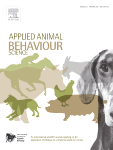Document type: scientific article published in the Journal of Dairy Science
Preview: This study aimed to investigate effects of pretransport diet (rearing milk vs. electrolytes), type of vehicle (open vs. conditioned truck), and transport duration (6 vs. 18 h) on physiological status of young calves upon arrival at the veal farm. A total of 368 calves were transported in 2 consecutive batches from a collection center to a veal farm. Blood samples were collected from calves before transport; immediately posttransport (T0); and 4, 24, and 48 h, and 1, 3, and 5 wk posttransport. Blood was analyzed for glucose, urea, lactate, nonesterified fatty acids (NEFA), β-hydroxybutyrate (BHB), creatine kinase, albumin, total protein, osmolality, calcium, sodium, magnesium, and hematological variables. Body weight, rectal temperature, and skin elasticity were determined before and immediately posttransport. Blood glucose, NEFA, and urea concentrations at T0 showed an interaction between pretransport diet and transport duration. Milk-fed and electrolyte-fed calves transported for 18 h did not significantly differ in plasma glucose concentration or serum NEFA concentrations. However, after 6 h of transport, milk-fed calves had higher plasma glucose and lower serum NEFA concentrations (4.71 mmol/L and 586.5 µmol/L, respectively) than electrolyte-fed calves (3.56 mmol/L and 916 µmol/L, respectively). After 18 h of transport, milk-fed calves had lower urea concentrations (5.40 mmol/L) than electrolyte-fed calves (7.38 mmol/L). In addition, at T0, after 6 h of transport, milk-fed calves gained weight (Δ = 0.41 kg), whereas electrolyte-fed calves lost weight (Δ = -0.16 kg). After 18 h of transport, both milk-fed and electrolyte-fed calves showed body weight losses (Δ = -0.67 and -0.74 kg, respectively). Type of vehicle had a limited influence on blood parameters. Concentrations of NEFA and BHB reached the maximum values at T0 and then decreased until wk 5 posttransport. The increase in NEFA and BHB concentrations between prior to and just posttransport (T0) was less pronounced in calves transported for 6 h (746.1 µmol/L and 0.38 mmol/L, respectively) than in calves transported for 18 h (850.6 µmol/L and 0.50 mmol/L). Overall, the recovery rate of calves at the veal farm seemed rapid; all blood parameters returned to (below) pretransport values within 48 h posttransport. We concluded that feeding milk before short-term transport helps young veal calves cope with transport, whereas this is not the case during long-term transport.






